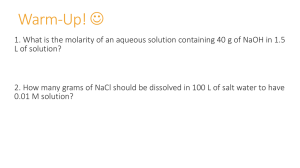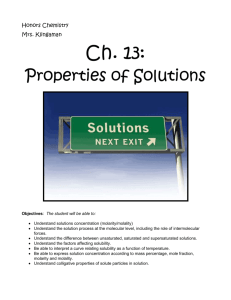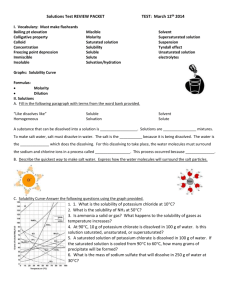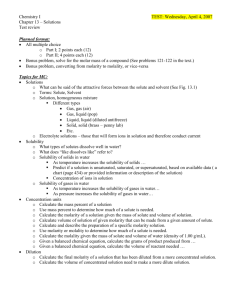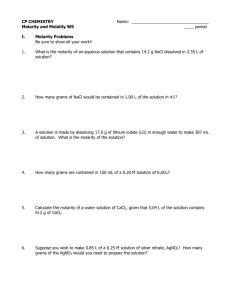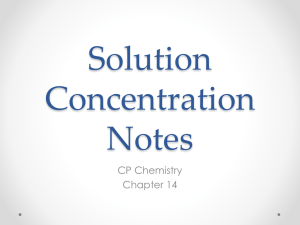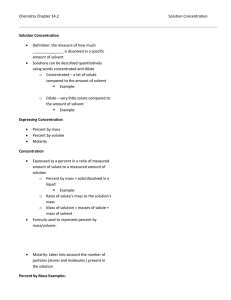Chapter 18 - Solutions
advertisement
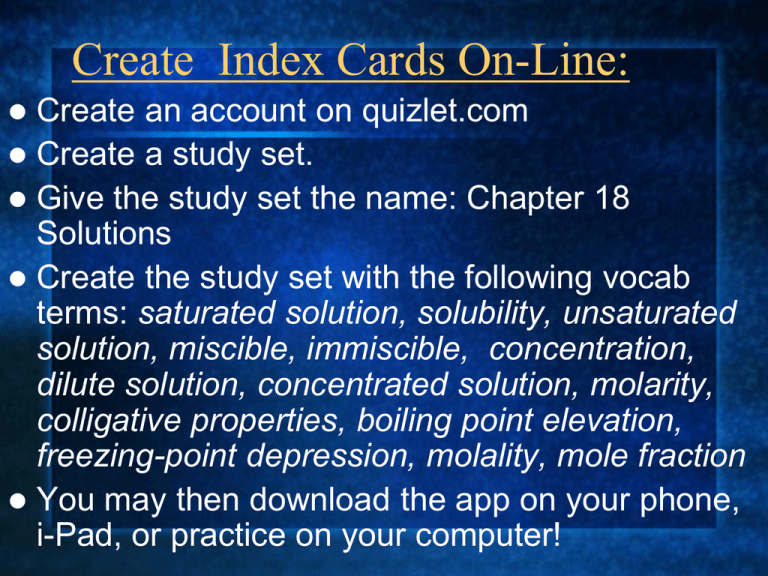
Create Index Cards On-Line: Create an account on quizlet.com Create a study set. Give the study set the name: Chapter 18 Solutions Create the study set with the following vocab terms: saturated solution, solubility, unsaturated solution, miscible, immiscible, concentration, dilute solution, concentrated solution, molarity, colligative properties, boiling point elevation, freezing-point depression, molality, mole fraction You may then download the app on your phone, i-Pad, or practice on your computer! Chapter 18 - Solutions 18.1 Properties of Solutions Solution Formation Solvent This is the liquid that is doing the dissolving Solute This is what is being dissolved Form a homogenous mixture Solubility When a solute is dissolved, an equilibrium is established: Equilibrium is a condition in which both reactants and products are present in concentrations which have no further tendency to change with time EXAMPLE: HC2H2O3 ↔ C2H3O2- + H+ Solubility When an equilibrium is established, the solution is said to be saturated If a solution is not at equilibrium, then it is said to be unsaturated (solution has the ability to hold more) Saturated vs. Unsaturated Solutions Solubility Two liquids that dissolve in each other are said to be miscible Immiscible other liquids are insoluble in each Immiscible vs. Miscible Solutions Factors Affecting Solubility Solubility increases with the increase in temperature (Easier to dissolve something when the temperature is increased) Solubility increases with an increase in surface area (ex. CRUSHING) Few exceptions that occur in the reverse Thursday, April 10th, 2014 PDN: What is the differences between miscible and immiscible? Saturated and unsaturated? Daily Log: Molarity Notes Molarity Calculations 18.2 Concentrations of Solutions Molarity is the concentration of moles per liters Molarity (M) = moles of solute / liters of solution Dilute solution contains a low concentration of solute Concentrated solution contains a high concentration of solute Practice Problems: Calculate the molarity of a solution which contains 0.40 mol of C6H12O6 dissolved in 1.6 L of a solution. What is the molarity of a solution containing 325 g of NaCl dissolved in 750. mL of solution?(1000 ml = 1L) Monday, April 14th, 2014 PDN: Determine the volume of a 1.7M solution containing 3.3 grams of NaCl. Daily Log: Science Scheduling Dilution Notes/Practice Problems Making Dilutions Formula for making a dilution C1 X V1 = C2 X V2 “Stock solution” is the same as the original solution. Example A stock solution of HCl has a concentration of 12M. How much of the stock solution would be required to make 325 mL of a 6M solution? Monday, April 21st, 2014 Daily Log: Molality Notes Practice Problems Chapter 18 Test on Friday Molality Molality is another way to represent the concentration of a solution. It is represented by a lower case m. Molality = moles of solute/kg of solvent Example: A 4.9m solution of NaCl is dissolved in 1000 grams of water. How many grams of NaCl is this? Tuesday, April 22nd, 2014 PDN: Determine the molality of a NaCl solution in which 17.3 moles of solute are dissolved in 1400 grams. Daily Log: Practice Problems Test on Friday! 18.3 Colligative Properties of Solutions Properties that depend on the number of particles dissolved in a given mass of solvent Boiling Point Elevation Freezing Point Depression Boiling-Point Elevation ∆Tb = Kb x m x i m is the molaity i is the number of ions in solution Kb is the molal boiling point elevation constant It is dependent on the solvent Freezing Point Depression ∆Tf = Kf x m x i m is the molaity i is the number of ions in solution Kf is the molal freezing point constant It is also dependent on the solvent Example: Determine the boiling point and freezing point of a solution in which 600 grams of MgCl2 is dissolved in 2400 grams of water. (Kb = 0.512 and Kf = 1.86)


